
Hurricane Maria made landfall in Puerto Rico Wednesday as a Category 4 storm, bringing record rainfall and catastrophic flooding, destroying power lines and leaving the entire country in the dark. This comes as many homes on Puerto Rico were still dark two weeks after Hurricane Irma cut electricity to hundreds of thousands. The storm also raised concerns about potential environmental disasters. Puerto Rico is home to 23 Superfund sites, including on the island of Vieques, site of a former U.S. naval test range, which took a near-direct hit from the storm. It is also the site of a coal-fired power plant owned by the private company AES. Residents across the island have been demanding the plant be closed and that the company stop dumping toxic coal ash into their community, saying the waste is poisonous to their health and the environment. We speak with Emily Atkin, staff writer covering the environment at the New Republic, who writes, “Puerto Rico is Already an Environmental Tragedy. Hurricane Maria Will Make It Even Worse.”
Transcript
NERMEEN SHAIKH: We begin today’s show in Puerto Rico, where Hurricane Maria made landfall Wednesday as a Category 4 storm, bringing record rainfall and catastrophic flooding, destroying power lines and leaving the entire country in the dark. Puerto Rico’s Governor Ricardo Roselló says at least one person has died, and the death toll is expected to rise when communication with the southeastern part of the island is re-established. This is Puerto Rican resident Grisele Cruz.
GRISELE CRUZ: [translated] And at this point, on many parts of the island, we’re without power because of the first storm that came through. That was Irma. We’re without water in many districts. Can you imagine this now? Catastrophic. We’re going to be, I think, without services for a long time.
NERMEEN SHAIKH: Hurricane Maria has already killed at least two people on the island of Guadeloupe and devastated the island of Dominica.
AMY GOODMAN: This comes as many homes in Puerto Rico were still dark two weeks after Hurricane Irma cut electricity to hundreds of thousands. The storm also raised concerns about potential environmental disasters. Puerto Rico is home to 23 Superfund sites, including on the island of Vieques, site of a former U.S. naval test range, which took a near-direct hit from the storm. It’s also the site of a coal-fired power plant owned by the private company AES. Residents across the island have been demanding the plant be closed and that the company stop dumping toxic coal ash into their community, saying the waste is poisonous to their health and environment.
For more, we’re joined by Emily Atkin, staff writer covering the environment at the New Republic. In her latest article, she writes, “Puerto Rico is Already an Environmental Tragedy. Hurricane Maria Will Make It Even Worse.”
Emily, welcome to Democracy Now! Talk about the environmental crisis as, at this point, after this storm, apparently 100 percent of Puerto Rico is dark. There is no electricity.
EMILY ATKIN: That’s true. And to what you said, their environmental crisis, every single major hurricane is a major pollution event, especially when it hits a populated area. But the fact that this major hurricane hit Puerto Rico, that’s an even more major pollution event, because Puerto Rico has extreme pollution problems.
You mentioned the fact that 100 percent of power is out across the island. That’s a problem—that would be a problem in any situation, because most sewage systems are run on electric pumps. Sewage systems easily become overwhelmed during flooding, especially, you know, if they’re shut off. If all the sewage systems are off, that means that there are going to be prolonged releases of sewage into floodwaters and into soil, which poses a long-term health risk if people come in contact with those waters or with that soil. That’s a normal problem.
There are other issues that are very unique to Puerto Rico and that have to do with their extensive financial crisis. And they’re situations that, frankly, we would not accept in mainland—in the mainland United States. One of those is the fact that most of the landfills on Puerto Rico are overflowing with liquid garbage. They’re at capacity. They do not have the financial means to create new landfills or secure them. What’s more, the coal ash, the toxic coal ash that you mentioned, is frequently dumped in these landfills. Flooding in those landfills threatens an overflow, threatens contamination of floodwaters. As you mentioned, as well, there’s coal ash disposed across the island in ways that are very controversial, one of which I talk a lot about in my piece is a five-story uncovered pile of coal ash. Five stories, think about that. That’s a large building, just of uncovered coal ash, sitting next to a community of 45,000 people. That community—I saw footage from that community where water was flowing through the streets like a river, and winds were whipping—you know, one of the more extreme wind videos that I’ve seen. So there are a lot of concerns that I could talk about for a while.
AMY GOODMAN: I just want to follow up on that coal ash point, because Democracy Now! just reported on the growing movement of Puerto Rican residents demanding the closure of the island’s only coal-fired plant and that the company, Applied Energy Systems, stop dumping toxic coal ash near the southern town of Peñuelas. This is resident Yanina Moreno describing the company’s track record.
YANINA MORENO: [translated] When the company AES was established in Puerto Rico at the end of the 1990s, the contract with the Authority of Electrical Energy, which supplies energy to Puerto Rico and its residents—the contract established that the residuals of carbon combustion and the ashes generated by the burning of coal in the plant would not be disposed here in Puerto Rico. Instead, they would be exported. So they began taking those ashes someplace else. And among those places was the Dominican Republic. A series of problems began there. The people who lived in the communities where the ashes were being disposed began presenting symptoms, including respiratory problems and pregnancy problems. Babies were born without extremities or with their intestines exposed.
From there, the situation in Peñuelas began, because they began depositing the ashes in the landfill. The landfill is very close, just meters away from various communities. So we have been resisting for two years. For two years, we’ve had an active encampment against the disposal of ashes in Puerto Rico.
AMY GOODMAN: That was Yanina Moreno, a resident, describing the company’s track record. It’s a longtime struggle now in Puerto Rico. Special thanks to Democracy Now!’s Laura Gottesdiener and Juan Carlos Dávila, who were in Puerto Rico to do that report. And that was before the storms, Emily, before the storms.
EMILY ATKIN: Yeah, there’s—like I said, there’s that five-story ash sort of pile. But then there are just sort of little piles of ash all over the southern part of the island. One of the things that I think your former guest was talking about was just the fact that this company transports the ash in open trucks, meaning that fugitive dust, aka coal ash that blows off in the wind, comes off and is just sitting on a lot of Puerto Rican riverbanks, a lot of the sides of roads. And what she mentioned about the health impacts, that’s something that’s been reported all over in places with coal ash, but it’s very hard to prove attribution from coal ash to human health impacts. And that’s what—the failings in the science there, or the inability of the science to do that at this moment, is what gets companies like AES off the hook in situations like this.
NERMEEN SHAIKH: And what about the situation, Emily, in Vieques? Can you talk about what’s going on there?
EMILY ATKIN: Yeah. Unfortunately, it’s very hard to get in communication with anyone in Vieques, because it is an island off of Puerto Rico, and they were also—that island of 9,000 people was also majorly hit by Irma. Irma skirted most of the mainland Puerto Rico, but it hit Vieques pretty hard. Vieques is now sort of a tourist destination, but for 60 years it was used by the U.S. military as a bomb testing site. And so, we would just explode munitions all over this island. And the result of that, we no longer use it as a bomb testing site because of protests and because of—because of contamination. Now it’s a federal Superfund site, because 75 percent of the island is contaminated with waste from the munitions. And that’s in the soil, and that’s in the water. There are also unexploded munitions—meaning bombs, ammunition, other types of explosives that are unexploded—all over the island. That’s not really a concern for them detonating, but it is a concern for them leaking whatever is in them, especially when very high winds and lots of flooding hit an area.
Like I said, Superfund concerns are always a problem. We saw that, Hurricane Harvey in the Houston area, with the San Jacinto Waste Pits potentially overflowing, and we’ve already seen spills from there. This is a situation where almost an entire island is a Superfund site. It’s a military—it’s one of the most contaminated, most expensive military Superfund sites we have. And it’s going to take a lot of effort and a lot of attention to assess, once we can get over there, once we can start talking to people, what exactly happened, how chemicals spread, if they spread, if munitions got into the ocean.
AMY GOODMAN: Interestingly, Emily, we just had Congressman Luis Gutiérrez on our show two days ago, before he got arrested at Trump Tower protesting immigration policy. He’s been arrested a number of times in those protests, but he was also arrested twice protesting the U.S. Navy’s bombing of Vieques. You talk about Superfund sites. Democracy Now! was in Houston after the hurricane at a Superfund site, as well. But just explain what they are. And also, what is FEMA and the EPA—of course, Puerto Rico is a part of the United States, Puerto Ricans are American citizens—doing right now with this storm? You know, we saw both of these storms coming, so much devastation on the island.
EMILY ATKIN: The EPA, from what I know, is not yet in Puerto Rico. I got a notice yesterday that they were waiting for conditions to stall, to not be so bad, before they sent people there to assess these Superfund sites. Superfund sites are the nation’s most industrially polluted sites. If a site gets the designation of Superfund, it means it’s not safe for you to walk there without protective gear. It means it’s not safe for you to touch the soil or touch water around there. They’re sites where—usually, you know, sort of during the Industrial Revolution, when we did not have environment regulations, paper mills, oil refineries, pharmaceutical companies, pesticide companies sort of freely released their waste into either groundwater, soil, pits—any situation that’s just gross, to be honest. And we see those—there are over a thousand all over the U.S., 23 in Puerto Rico.
And like I said earlier on the program, there’s always a risk of contamination, of contaminants spreading from Superfund sites, when a major hurricane hits. And it’s something that we’re going to be dealing with in Puerto Rico. It’s something we’re dealing with in Florida now, in Texas, and that we’ll continue to deal with, so long as these sites remain contaminated and so long as we keep getting more intense hurricanes.
AMY GOODMAN: Well, Emily, we’re going to link to your piece, staff writer on the environment at the New Republic, “Puerto Rico is Already an Environmental Tragedy. Hurricane Maria Will Make It Even Worse.” Thanks so much for joining us.
When we come back, leading economist Jeffrey Sachs on, well, President Trump’s speech, North Korea, Iran, Afghanistan, climate change and more. Stay with us.

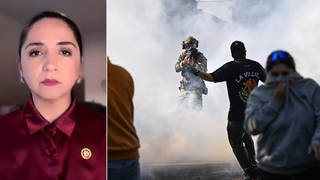
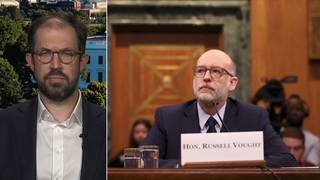
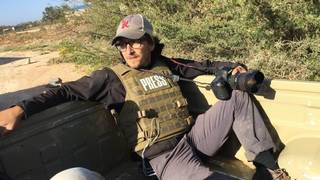
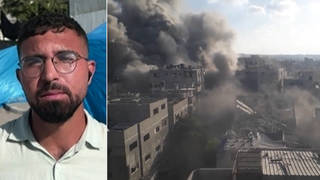





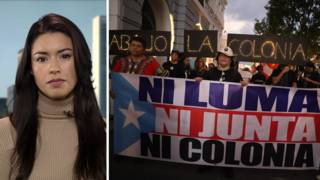

Media Options